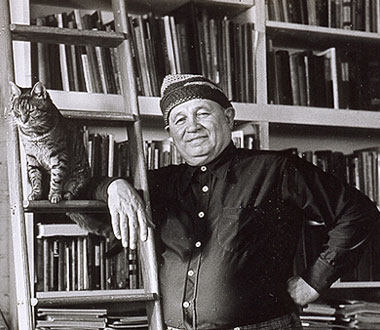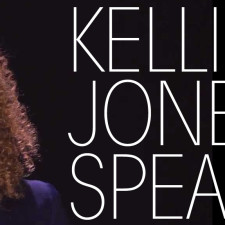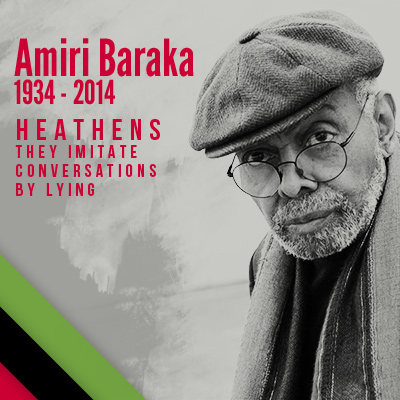At the same time that early bebop musicians forged their new musical language, a community of black visual artists and writers thrived in New York. Black artists experimented across mediums and manipulated the forms, vocabularies, and scope of their work, and in the process they expanded, questioned, and challenged the range of acceptable representations of “blackness” in the artistic realm. Music proved to be a central theme and, perhaps, a preoccupation among these disparate artistic movements.
Romare Bearden (1911-1988) gave his first solo exhibition in the spring of 1940, under the auspices of Harlem’s “306,” a diverse and informal circle of artists, writers, and musicians. Headquartered at 306 West 141st Street in upper Manhattan, the group offered a community of support, providing a cross fertilization of ideas. Painter William H. Johnson and writers Langston Hughes, Ralph Ellison, Richard Wright, and Alain Locke were among the regular visitors to the decidedly male artistic collective. Bearden, once described as “an Omni-American . . . part urbane Harlemite and part blues-idiom hero,” used music as a recurring theme in his art. He absorbed the sights and sounds of Harlem and compared the structure and process of his art to jazz improvisation. Bearden was very much aware of the presence of Charlie Parker, Dizzy Gillespie, and Bud Powell during bebop’s early years.
After moving to Harlem in 1939, following twelve years living in Europe, art historian Richard Powell notes that William H. Johnson (1901-70) abandoned the landscapes and still life work he painted overseas and redirected his focus toward African-American culture. By doing so, he tried to capture the imagination, rhythm, and spirit of black America in the 1940s. Johnson’s use of sharp angles and vivid splashes of color seem to visually represent some of bebop’s musical traits. But, in my view, other painters would capture the spirit of the music more directly.
Indeed, for black visual artists of this time and place, the air weighed heavy with the possibilities embedded in experimentation. Some African American artists such as Norman Lewis (1909-79) sought to break through the boundaries of racial representation in the their work altogether. For Lewis, this meant a move toward abstraction, although as art historian Kellie Jones points out, his work in the early 1940s oscillated “between representational and purely abstract styles for a number of years.” This moving back and forth between representation and abstraction I find analogous to Powell’s moving among bebop and other less experimental musical styles early in his career.
In 1946, Lewis grew concerned with what he saw as the limitations of having his work labeled names such as “African Idiom,” “Negro Idiom,” and “Social Painting.” Lewis’s resentment of the social pressure to produce paintings considered “black” resounds with that of bebop musicians who resisted the word “bebop” in lieu of the more expansive term “modern.” Lewis believed that by moving away from social realism and figuration and into the realm of abstraction he could not only free himself from the burden of mimetic representation but also grow as a human being. As art historian Ann Gibson has shown, Lewis’s refusal to play the role of noble savage, his self-conscious articulation of his artistic inner life, the stylistic flexibility and deliberate mutability of his work, and his somewhat uneasy relationship with the artistic critical establishment make his art drenched in the cultural politics of the 1940s.
While he intentionally distanced his paintings from the social protest and realism of previous generations, Lewis’s paintings were praised for their connections to jazz. Critics use musical metaphors to describe his
painterly technique, referring to it as “pure eye music” and noting his “lyrical touch.” One writer stresses the musical qualities of a painting as it unfolds in real time: “He starts softly on the blank page like a musician improvising, and as he sees a suitable motif taking shape, swings into it with confidence, plays it for what it is worth, and then, satisfied he has gone the whole way with it, permits it to fade softly out.”
The move toward abstraction by black artists shares other affinities to jazz. Lowery Stokes-Sims has argued that black visual artists had developed during the early twentieth century what she calls an “aesthetic system of figuration” that sought to express visually the notion of black identity. For the most part, it drew on African aesthetic sensibilities and leaned heavily on realist figuration, and thus, could be easily identified as “black.” Musicians also forged a musical language—a schemata of gestures, forms, and techniques historically associated with the social experience of black Americans—that expressed for many, black subjectivity and the “collective unconscious,” as artist Jack Whitten once put it, following Jung.
The musical styles that essentially constituted an aesthetic system of black musical figuration were marketed in the “race music” category by the industry. Easily identifiable (or so it was believed) as black, it was promoted by the industry as targeting African American audiences, although it was well-known that its fan base had swelled beyond this narrow demographic. Nonetheless, African Americans did invest in black music their own meanings, and powerfully so. Thus, when bebop musicians began to move beyond the conventions of black figuration and move gradually toward abstraction, a turn that would ultimately culminate in the free jazz movement, some grew uncomfortable with the development. If diatonic melodic and harmonic structures, pentatonic scales, danceable isorhythmic patterns, and American popular song formed an important structural basis for black music, bebop and free jazz challenged these boundaries, and by extension, the social structures that were built alongside of this music.
The bold experimentations of color, form, and symbolism in visual abstraction found a suitable musical analogy in the disjunctive melodies, dramatic rhythmic conceptions, chromaticism, and harmonic experimentations of bebop. In both the visual and musical realms, abstraction was equated among its practitioners with both artistic and social freedom. Furthermore, with the elevated role of virtuoso improvisation at the heart of bebop practice and the idea that visual abstraction allowed viewers access to the painter’s unconscious interiority, we see in each the “making” of complex black subjectivities in the public sphere.
Tags: abstraction, Ann Gibson, Bebop, Jitterbugs, Kellie Jones, Lowery Stokes Sims, Norman Lewis, Richard Powell, Romare Bearden, William H. Johnson






 Share On Facebook
Share On Facebook Tweet It
Tweet It





